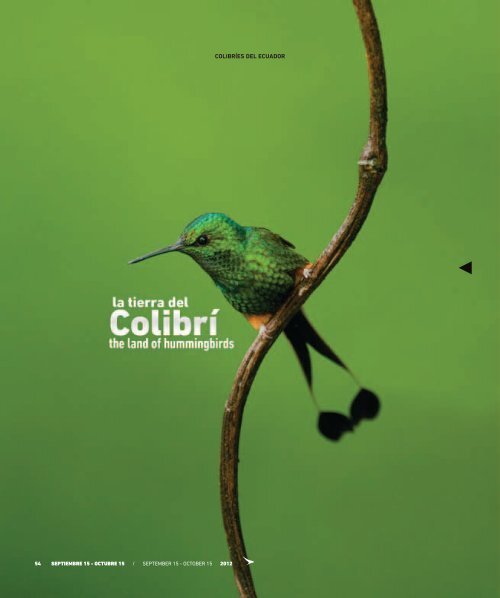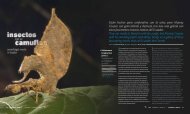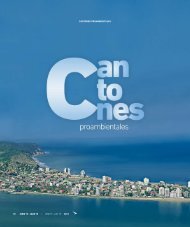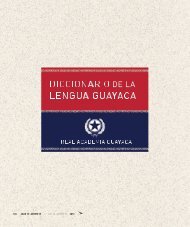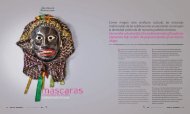La tierra del Colibrà - Abordo.com.ec
La tierra del Colibrà - Abordo.com.ec
La tierra del Colibrà - Abordo.com.ec
- No tags were found...
Create successful ePaper yourself
Turn your PDF publications into a flip-book with our unique Google optimized e-Paper software.
54 SEPTIEMBRE 15 - OCTUBRE 15 / SEPTEMBER 15 - OCTOBER 15 2012COLIBRÍES COLIBRIS DEL ECUADOR
Presentamos a nuestros l<strong>ec</strong>tores una sel<strong>ec</strong>ta galeríafotográfica, segmentada por regiones naturales, con algunasde las esp<strong>ec</strong>ies de colibríes más bellas que habitan en Ecuador.We offer our readers a sp<strong>ec</strong>ial gallery of photos, divided upby natural regions, with some of the most beautiful sp<strong>ec</strong>ies ofhummingbirds that inhabit Ecuador.Texto / text: Xavier Gómez Muñoz_fotografía / photography: Murray CooperFoto de apertura:Cola EspátulaZamarrito / BootedRacket-tail˜Ocreatus underwoodii˜Hábitat: bosque subtropicaly piemontano desde elnorte de Venezuela hasta elsur de Bolivia. / Foothills andsubtropics from northernVenezuela to southernBolivia.Exclusivamente el continente americano es el hogar deuna de las criaturas aladas más fascinantes <strong>del</strong> reinoanimal. Los científicos dicen que perten<strong>ec</strong>e a la familia <strong>del</strong>os Trochiliformes; otros la conocen simplemente <strong>com</strong>ocolibrí, quinde o picaflor. En todo caso, el nombre es lode menos. Lo importante es respetar y conservar estaagraciada y <strong>com</strong>pleja ave, que despierta con su coloridoplumaje y vuelo particular el asombro <strong>del</strong> ser humano.Como ya se ha dicho en reiteradas ocasiones, Ecuador esun territorio bend<strong>ec</strong>ido por su biodiversidad y encantosnaturales. Lo propio en cuestión de aves y, cómo no, enavistamiento de colibríes, debido a que dispone de 130esp<strong>ec</strong>ies, de las cerca de 300 registradas en el continente.Pero la fama de Ecuador, <strong>com</strong>o <strong>tierra</strong> de colibríes, no estádada solamente por la cantidad de esp<strong>ec</strong>ies que habitanen sus tres regiones naturales: Sierra, Costa y Amazonía,sino también por ser la sede de extraordinarias variedades<strong>com</strong>o la Pico de Espada, el ave con el pico más largo <strong>del</strong>planeta en proporción al tamaño de su cuerpo, el TopacioFuego, cuyo cuerpo literalmente par<strong>ec</strong>e estar cubierto enllamas, o el Silfo, con su alargadísima cola violeta.Un dato curioso es que la fastuosa coloración de loscolibríes no se debe a la pigmentación de sus plumas,<strong>com</strong>o pensábamos la mayoría, sino a células prismáticasque al contacto con la luz, la des<strong>com</strong>ponen en distintaslongitudes de onda, provocando variaciones en color eintensidad, según el ángulo de cada observador. Así loThe two American continents are the exclusive hometo one of the most fascinating winged creatures in theanimal kingdom. Scientists say that they belong to thefamily of Trochiliformes, while others simply know themas hummingbirds. What is important is the resp<strong>ec</strong>t forand conservation of this beautiful and <strong>com</strong>plex bird thatpeaks the interest of humans with its colorful feathers andunique manner of flight.Ecuador is a territory blessed by its biodiversity andnatural wonders. Ecuador is essentially the home tohummingbirds, and how could it not be? Ecuador ishome to 130 sp<strong>ec</strong>ies of the nearly 300 sp<strong>ec</strong>ies that havebeen r<strong>ec</strong>orded on the continent. Nevertheless, Ecuador’sfame as the land of hummingbirds is not only due to thequantity of sp<strong>ec</strong>ies that inhabit its three natural regions:Highlands, Coast and Amazon, but also b<strong>ec</strong>ause it isthe site of extraordinary varieties, such as the swordbillhummingbird, which is the bird with the longest billon the planet in proportion to its body; the ruby-topazhummingbird, which literally looks like its body is coveredin flames; or, the sylph, with its extremely long violet tail.A curious pi<strong>ec</strong>e of information is that the lavish coloring ofhummingbirds is not due to pigment in the feathers, as themajority of people previously thought, but due to prismaticcells that de<strong>com</strong>pose in different wavelengths whenthey are exposed to light, causing variations in color andintensity, depending on the angle of the observer. This isthe explanation provided by photographer Murray Cooper,2012 SEPTEMBER 15 - OCTOBER 15 / SEPTIEMBRE 15 - OCTUBRE 15 55
Ninfa Ventriesmeralda/Emerald-belliedWoodnymph˜Thalurania fannyi hypochlora˜Hábitat: esp<strong>ec</strong>ie nativa debosques piemontanos ysubtropicales al suroccidentede Ecuador y extremonoroeste de Perú. / Endemicto foothill and subtropicalforests in southwest Ecuadorand extreme northwest Peru.Brillante P<strong>ec</strong>hianteado/Fawn-breasted Brilliant˜Heliodoxa rubinoides˜Hábitat: bosque subtropical,desde el norte de Colombiaal sur de Perú. / Mainlysubtropical forests fromnorthern Colombia tosouthern Peru.COSTA60 SEPTIEMBRE 15 - OCTUBRE 15 / SEPTEMBER 15 - OCTOBER 15 2012
Coronitaaterciopelada/ VelvetpurpleCoronet˜Boissonneaua jardini˜Estrellita esmeraldeña /Esmeraldas Woodstar˜Chaetocercus berlepschi˜Hábitat: esp<strong>ec</strong>ie endémica de los Andesoccidentales de Colombia y el norte de Ecuador./Endemic to the Pacific slope of the Andes inColombia and northern Ecuador.Hábitat: esp<strong>ec</strong>ie endémica <strong>del</strong> bosque tropical,suroeste de Ecuador (provincias de Manabíy Santa Elena) / Endemic to humid forests insouthwest Ecuador (Manabi and Santa Elenaprovinces).
Coqueta Crestirufo/Rufous-crested Coquette˜Lophornis <strong>del</strong>lattrei˜Hábitat: Amazonía <strong>del</strong> surde Colombia hasta este dePerú./ Amazon from southernColombia to eastern Peru.Colicerda Crestuda /Wire-crested Thorntail˜Popelairia popelairii˜Hábitat: Amazonía <strong>del</strong> surde Colombia hasta este dePerú./ Amazon from southernColombia to eastern Peru.amazonía62 SEPTIEMBRE 15 - OCTUBRE 15 / SEPTEMBER 15 - OCTOBER 15 2012
Zafiro Colidorado /Golden Tailed SapphireHábitat: se distribuye desde Venezuela hastaBolivia. / Found from Venezuela to Bolivia.˜Chrysuronia oenone˜


